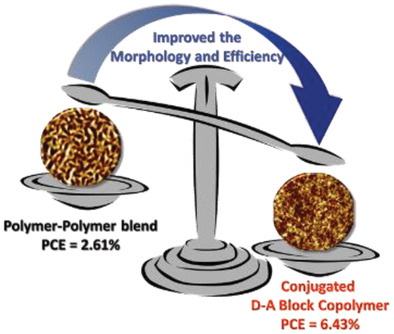
박수홍 (제 1저자, 박사과정)
A highly crystalline conjugated donor (D)–acceptor (A) block copolymer (PBDT2T‐b ‐N2200) that has good solubility in nonhalogenated solvents is successfully synthesized. PBDT2T‐b ‐N2200 shows a broad complementary absorption behavior owing to a wide‐band gap donor (PBDT2T) present as a D‐block and a narrow‐band gap acceptor (N2200) present as an A‐block. Polymer solar cells (PSCs) with conjugated block copolymer (CBCP) are fabricated using a toluene solution and PSC created with an annealed film showing the highest power conversion efficiency of 6.43%, which is 2.4 times higher than that made with an annealed blend film of PBDT2T and N2200. Compared to the blend film, the PBDT2T‐b ‐N2200 film exhibits a highly improved surface and internal morphology, as well as a faster photoluminescence decay lifetime, indicating a more efficient photoinduced electron transfer. In addition, the PBDT2T‐b ‐N2200 film shows high crystallinity through an effective self‐assembly of each block during thermal annealing and a predominant face‐on chain orientation favorable to a vertical‐type PSC. Moreover, the CBCP‐based PSCs exhibit an excellent shelf‐life time of over 1020 h owing to their morphological stability. From these results, a D–A block copolymer system is one of the efficient strategies to improve miscibility and morphological stability in all polymer blend systems.

https://doi.org/10.1002/advs.201902470
 Mechanical Force Induces Ylide-Free Cycloaddition of Nonsciss...
Mechanical Force Induces Ylide-Free Cycloaddition of Nonsciss...


















